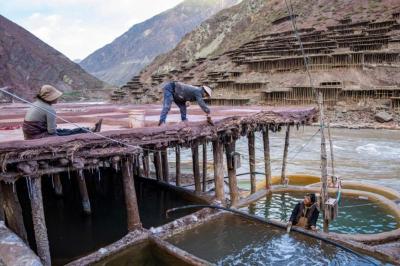| Aug.31,2017-- Over the past few year Tibet has intensified the construction of high-speed rail while balancing the ecological protection.
Working through the heat: Sangzhuling Tunnel and Lhasa-Nyingchi Railway
With water dropping from the top of the Sangzhuling Tunnel of the Lhasa-Nyingchi Railway, the excavator is working through chunks.
Discussing inside the tunnel, Zhu Xuren, project manager of the fifth section of Lhasa-Nyingchi Railway introduced, "This is a project conducted at a super-high altitude environment. The highest temperature of this tunnel since 2015 was 63 degrees Celsius and the highest ever reached was 89 degrees Celsius."
As a major project along the Lhasa-Nyingchi Railway, the Sangzhuling Tunnel will become the second tunnel along the railway. The tunnel will be over 16 kilometers, and by the end of July, around 14 kilometers will have been tunneled through. In order to combat the heat, ice blocks and water sprays have been utilized, and temporary mobile lounges with air conditioners have been set up.
Such difficulties in construction have not distracted the focus on ecological protection. Instead of being chopped down, the trees along the railway have been relocated to other spots. Moreover, the waste dregs from the construction works have been placed in fixed sites for follow-up treatment.
The Lhasa-Nyingchi Railway, as the shared section of the Sichuan-Tibet Railway, the Yunnan-Tibet Railway and the Gansu-Tibet Railway, will become the first electrified railway in Tibet after completion.
Picturesque Line: Nyingchi-Lhasa High Grade Highway
The bridge, the reservoir and the surrounding scenery comprise a beautiful picture for visitors passing by, Song Xiancai from the transportation department of China's Tibet Autonomous Region introduced.
In front of Song and the extended Duobute Bridge, standing by the roadside of the original 318 national highway (G318), a bird's eye view of part of the bridge can be enjoyed. Amazed by the project and the view, a few cycling visitors also stopped by to take photos.
Built from May 2013 to September 2015, the first-phase of the Nyingchi-Lhasa High Grade Highway runs along the G318 corridor, and therefore, its construction did not disturb the operation of the G318 line. On this basis, the new highway stretches to Liuwu New Area of Lhasa, and connects with the Lhasa-Gongga Airport highway, facilitating the transport to scenic spots for visitors.
In addition, significant inputs have been made to the maintenance of the bridge and the highway and the related monitoring technologies to ensure their readiness to different temperatures. In summer, water sprays absorb the heat. In winter, besides traditional methods like covering cotton quilts or thin films, color steel cabins with boilers have also been set up to maintain a proper temperature for the cement structure. With water vapors suffused, the cabins can guarantee a temperature of over 15 Celsius degrees in winter.
Ecological protection and recovery featured both in the construction and the follow-up work. The straw mattresses covering the ground, once decayed, offer nutrients for the plants.The spray seedling technique helps to afforest the roadbed. Moreover, for the 15 construction sites along the way, soil of 10 to 30 centimeters thick was placed for plants to grow.
The 409.2-kilometer Nyingchi-Lhasa High Grade Highway is set to be finished and opened to the public by April 2018 and will be equipped with a higher load capacity, transport efficiency and safety level.
"It used to take eight hours to drive from Nyingchi to Lhasa. With the Nyingchi-Lhasa High Grade Highway, it will be cut by three hours," Song said.
Since 2012, the total mileage of highways in Tibet has increased by 16,802 kilometers to over 82,000 kilometers currently, including highways to Ngari Prefecture and the remote Medog County. By 2020, this figure is expected to reach 110,000 kilometers, according to the transport department of China's Tibet Autonomous Region.
|
- Home
- News Tibet |Exclusive |China |World |Related News |Latest
- Documents White Papers |Others
- Photo Politics |Economy & Society |Culture & Religion |Human & Nature |Beautiful Tibet |Other Tibetan-Inhabited Area |Exchanges |Related
- Video News |Documentary |Micro-Video |Entertainment
- Art
- Tourism
- In Focus
- About Tibet






